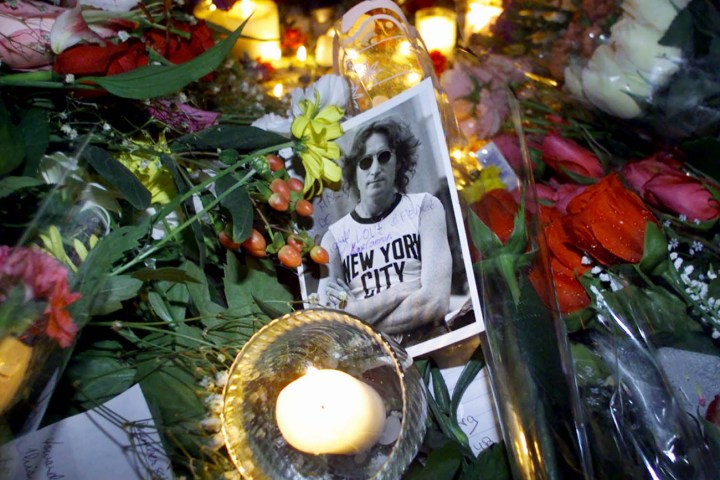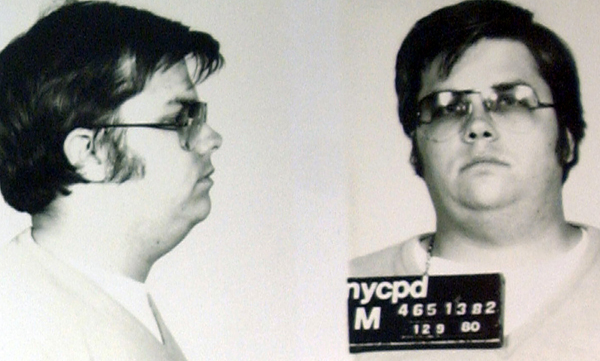Media
Remembering John Lennon: Three decades later, superlatives still apply

In the weeks after Mark David Chapman fired four bullets into the back of John Lennon outside the Dakota in Manhattan, the world’s greatest editors – amongst them William Shawn and Jann Wenner – were scrambling for words and images to do justice to a life that touched us all. More recently, some have suggested that we don’t want to get too sentimental about the Beatles’ frontman. The Daily Maverick disagrees. By KEVIN BLOOM.
Soon after John Lennon was assassinated on 8 December 1980, the New Yorker’s editor, the legendary William Shawn, wrote an obituary notice. Shawn understood that Lennon was a supremely gifted “composer, poet, and performer,” and he said as much in the piece, but what really struck him about the man was the remarkable and unique message. The words Shawn employed to frame the point were, and are, as ageless as the subject itself: “Beyond, and in spite of, his unparalleled and burdensome celebrity, he remained truly a man of the spirit – this humorous and friendly man who held on to his humanity against awesome odds, and who did not lecture us but, rather, spoke to us quietly, and in ways that we all understood. In what he said directly, in what he said in his very beautiful songs, and in the way he tried to live his far too brief life, the message that came through – and how rarely we hear such a message – was: Be peaceful, be loving, be gentle.”
Like the assassination of JFK, or the Moon landing, or 9/11, most people who were alive at the time remember where they were when Lennon was killed. I was seven years old, and a friend of my mother’s had given our family the use of his home in Llandudno for the holidays. From the stunned silence of my parents as we watched the eight o’clock news, I sensed something profound had just happened. If I didn’t know who John Lennon was before that day, it became from then on a name I would always associate with an idyllic holiday on the Atlantic coast.
Watch: The Beatles In My Life (2009 Stereo Remaster)
Which is relevant in the sense that the man’s influence, in life as in death, has been oceanic. Thirty years later, hardly a week goes by that some top-tier international media outlet doesn’t mention him. On Wednesday 24 November it was the Guardian, which noted that the album Lennon signed for Mark David Chapman, five hours before Chapman shot him, was up for auction at a starting price of £535,000.”The album is the most extraordinary artefact in rock’n’roll history,” a spokesman for the seller told the newspaper. “I have never come across a piece with such provenance. Police reports, fingerprint documentation, letters from the [district attorney], it goes on and on.”
As implied, the circumstances of Lennon’s assassination have remained inextricable from the legend. Chapman, at 25 years old, had initially planned to do the deed in October 1980, but turned back. A month later he waited outside the Dakota, the Manhattan apartment building in which Lennon and Yoko Ono lived, but decided against it again. Finally, on the morning of 8 December 1980, he stood opposite the building with a copy of JD Salinger’s The Catcher in the Rye in one hand and Lennon’s “Double Fantasy” – which he wanted signed – in the other. Distracted, he missed Lennon leaving the Dakota in the morning, and only got the autograph at 5pm, when Lennon and Ono emerged once more. At 10.49pm, the Lennons returned from the Record Plant Studio, where they had just recorded Ono’s “Walking on Thin Ice”. Ono went ahead of her husband into the Dakota’s reception area. Chapman was standing in the shadows of the archway, and Lennon looked at him briefly before continuing towards the entrance. Seconds later, Chapman took aim at the centre of Lennon’s back, firing five hollow-point bullets from a .38 revolver.

Photo: A mug-shot of Mark David Chapman, who shot and killed John Lennon, is displayed on the 25th anniversary of Lennon’s death at the NYPD in New York December 8, 2005. Chapman is currently imprisoned at Attica State Prison in New York, serving a 20-year-to-life sentence after pleading guilty to 2nd degree murder. REUTERS
The first bullet missed, the next two hit the left side of Lennon’s back, the last two hit his left shoulder. Lennon stumbled up the steps to the reception area, mumbled “I’m shot,” and collapsed. He was pronounced dead on arrival at the Roosevelt Hospital at 11.15pm. Back at the Dakota, officers of the New York Police Department found Chapman sitting calmly on the pavement. He was holding a copy of The Catcher in the Rye, in the front of which was inscribed: “To Holden Caulfield. From Holden Caulfield. This is my statement.” It would later emerge that Chapman – who in September this year was denied parole for the sixth time – felt his life mirrored that of Salinger’s troubled protagonist.
But the world didn’t care about Chapman or his issues. The outpouring of grief was unprecedented, and sales of Lennon’s albums – both with the Beatles and as a solo artist – soared. All-night chanting outside the Dakota began to deprive the shattered Ono of sleep, so she requested that the vigil be moved to Central Park: on 14 December 1980, in accordance with Ono’s wishes, millions of people worldwide stood for ten minutes of silent prayer. In the weeks that followed, after William Shawn had penned his famous obituary, Jann Wenner of Rolling Stone magazine sat with his editorial team to decide which image to put on the iconic title’s cover. On what would be the last day of his life, Lennon and his wife had posed for a session with photographer Annie Liebovitz; one of the photos featured a naked Lennon curled around the clothed body of Ono, his mouth pressed close to her cheek. Wenner ran the photograph on the cover of the 22 January 1981 issue, without any barkers or text. The thousand words that the picture spoke were in effect a single word: love. In 2005, to mark the fortieth anniversary of the annual awards held by the American Society of Magazine Editors, the cover was voted the best of the previous four decades.
Watch: Imagine – Live in New York
Of course, without the life, the death would hardly have been as momentous. Amongst the many biographies that have been written on the man, the most lauded is arguably Ray Coleman’s Lennon: The Definitive Biography. In the author’s note to the text, Coleman writes: “History will record him as one of the great peacemakers of the twentieth century. Teddy boy, pop star, rebel student, propagandist for peace, poet, artist, songwriter, musician, bandleader, sloganeer, philosopher, wit, loving husband, doting father – Lennon was all these things and more. The founder, the powerhouse, the engine room of the Beatles, he became a catalyst and a dream-weaver for a generation’s ideals.
“Without him, the Beatles would never have existed, still less have become popular music’s finest group; without him, they would have had no cutting edge, conscience, or originality. And without him, the 1960s and its people would have been very different, much colder, much poorer.”
It’s beyond the purview of this article to detail exactly what Coleman meant by these words; The Daily Maverick will assume that its readers are familiar enough with both the music and the legacy to render such a task unnecessary. But what may be worthwhile addressing in more depth is the transformation of Lennon from frontman of the Beatles in the early ’60s to rallying anti-war activist of the Nixon era, as outlined in the 2006 documentary by John Sheinfield and David Leaf, The US vs. John Lennon.
Watch: Stand By Me, live (1975)
The film features a montage of archived and current footage – performances by Lennon, interviews with Lennon and Ono, interviews with people who knew Lennon best – to arrive at a polarised documentation of the US government’s attempts to silence the rabble-rouser for peace. We see the build-up of fear amongst representatives of the government and the CIA, which eventually resulted in the deportation notice sent to Lennon’s house, informing him that “his temporary stay in the USA was now over”. We see public officials reacting like repressed schoolmarms to instances of so-called drug abuse “perpetrated” by Lennon and other famous figures. We see outtakes of scenes that have since imprinted themselves on the retinae of contemporary culture – the “Give Peace a Chance” rally, the wearing by Lennon and Ono of bags over their entire bodies to satirise prejudice and stereotyping (a concept termed “bagism”), the two-week long “Bed-ins for Peace” in Amsterdam and Montreal.
In his review of the documentary for the New York Times, published under the sub-title “Lennon as Superior to Nixon”, AO Scott trenchantly comments: “That very few people are likely to need persuading on this point is something of a problem.” Lennon, Scott was saying, was proved by history to be the better man; the movie, as a consequence, didn’t add much. But Scott goes on: “Luckily, even 26 years after his death, Lennon is a lively enough presence to keep the sentimentality somewhat in check. A great songwriter and a nimble exploiter of his own celebrity, he was also a pretty terrific television talk show guest: witty, engaged and passionate about his beliefs without being pompous about it.”
Thirty years to the day after his death, as the eulogies and calls to sainthood flood the world’s media yet again, we’d all do well to remember Scott’s implied injunction against mawkishness. Problem is, even after all these years, it remains nigh impossible not to lionise John Lennon. If William Shawn, Jann Wenner and the master biographer Ray Coleman couldn’t hold back, why should The Daily Maverick? DM
Read more: “William Shawn on John Lennon,” in the New Yorker, “Album John Lennon signed for his killer to be auctioned,” in the Guardian, “1981 Rolling Stone pic of ex-Beatle chosen as best in past 40 years,” by Associated Press, Review of The US vs. John Lennon in the New York Times.
Main photo: A photograph of slain musician John Lennon sits amid flowers and candles on the 20th anniversary of his murder in the Strawberry Fields area of New York’s Central Park December 8, 2000. Strawberry Fields sits across the street from the Dakota apartments where Lennon was murdered by Mark David Chapman. Hundreds packed the area which is dedicated to the memory of the ex-Beatle for a candlelight vigil throughout the day. Reuters.















 Become an Insider
Become an Insider